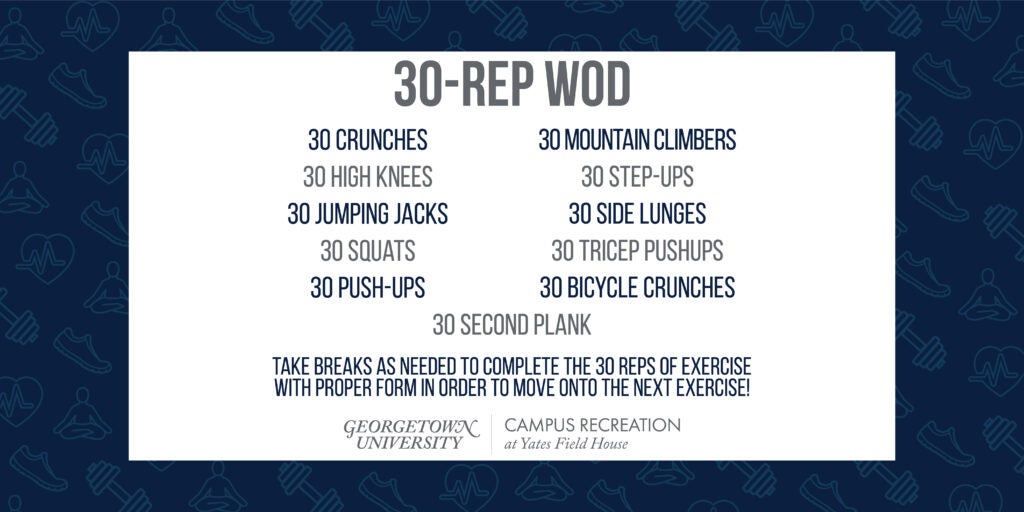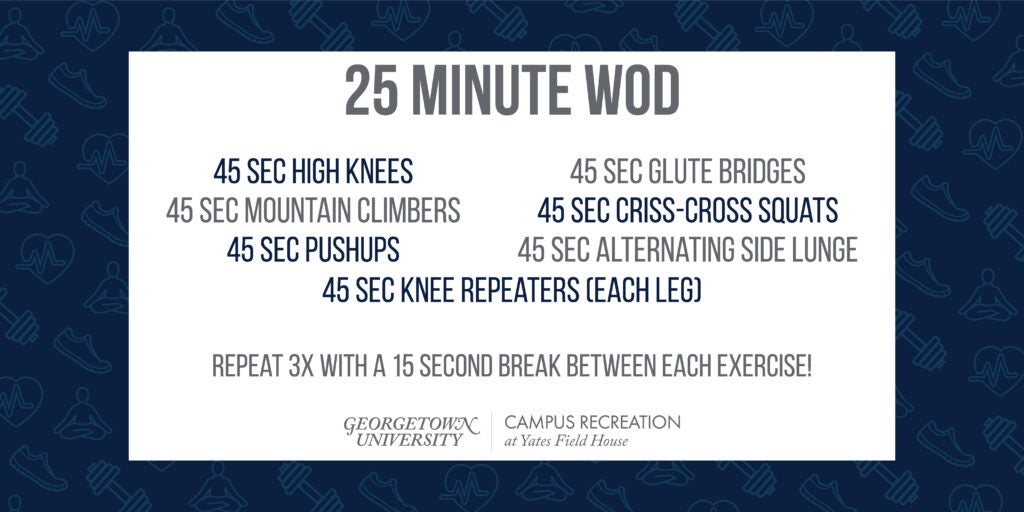How to Revamp Your Workouts, and a Special, Designated Area in Yates for Your WOD!
Posted in Announcements Blog Fitness Fitness & Wellness Corner News
By Christie Tippett, Assistant Director of Fitness
March Fitness & Wellness Corner
So you’ve found yourself adapted to all of your favorite workouts and exercises that the internet has to offer (or rather, that you’ve discovered thus far). You may be asking yourself, “now what?” Well, don’t give up that easily on your favorite workout, as we may have a solution for you! As fitness professionals, we need to get creative with our workouts, and know how to continually progress them. This doesn’t mean just tagging on an additional 10 repetitions of something…it’s way more than that, and there are MULTIPLE ways to go about it!
Below is a list of ways to increase complexity and/or intensity of your workout. Please keep in mind the importance of only changing 1-2 components at a time to properly train the body and help prevent overtraining.
- Increase the amount of repetitions
- Add an external weight option
- Make a simple move, a complex move
- Increase the time interval in which you are performing the exercise
- Shorten your rest period
- Add another round/set
- Change your base of support/stability
For starters, we talked about the F.I.T.T. principle in one of our A&P crash course videos. This is what fitness professionals use to create exercise programs. Gradually changing one factor of the F.I.T.T. principle will help you continue to work toward the overload principle, which is how we adapt and increase our performance over time. Another way is to find alternative equipment options. We have an awesome blog post on at-home alternatives for exercise equipment to use in order to add external weight to your workouts with objects lying around the house! This is another easy way to add on or increase the challenge of your workout.
More specifically, I am going to give you a few example WODs that we have created, and describe different ways to add progressions, or rather, increase the intensity of the workout.

Above you can see there are 11 different exercises. Looking at this workout, how would you increase the challenge? Would you add more reps? Perhaps you would add another round of it. Those are both fine ways to do so, but let’s dive a little deeper! What if we took these simple exercises and made them more complex, or even added a plyometric component to it? For example, what if we progressed the air squats by either adding a shoulder press at the top (which then becomes a more complex movement) or added jumps in between each squat to make it a plyometric jump squat? What if rather than ‘regular’ step-ups, we added a knee drive or a hip extension at the top? We can even add an external weight to increase the intensity for any of these exercises as well. You see, there are many options to increase complexity in our workouts, we just have to plan ahead!
Below is another example of a WOD we previously made. Apart from the suggestions mentioned above, such as adding on to certain moves, this 25-minute WOD can become more challenging by decreasing the amount of rest between each exercise. For example, rather than 15 seconds in between each exercise, we can decrease it to 10 seconds. This allots for a shorter recovery time, shifting the workout to a more muscular endurance-based session. Another option would be to add to the amount of time you are doing each exercise such as performing each move for 60 seconds, with a 30 second break in-between. Which leads me to two last options: 1) increasing the length of the workout by either performing the move longer, or by adding another round, and 2) changing your base of support! What does that mean? Rather than completing the push-ups with our hands on the stable ground, try placing them on a bosu ball! This would increase the challenge substantially as it would force us to work in additional shoulder stability during the exercise. Another example of changing the base of support would be to use a step for the knee repeaters. This uneven elevation causes more stress on the working muscles and forcing them to work harder, completing a larger range of motion.

The beautiful thing about increasing the intensity of a workout is that you are in control of it; YOU get to choose what you’re in the mood to change that day. If you are interested in creating your own WOD, we have a blog post for you about that too!
Wondering where to perform these workouts in Yates Field House when we reopen? Great news! We will have specific areas called HIIT Courts in which you will be able to reserve a time slot and have the entire court to yourself! You will be well equipped with everything you might need for one of (y)our WODs, including equipment that will allow you to increase the challenge of the workout! From a piece of cardio equipment, to dumbbells, to boxes or steps, it is all waiting in that court, just for you! Be sure to check out all courts while reserving, as each one has different equipment available.
There you have it! While there are many different ways to increase the intensity of a workout, I encourage you to play around with it a little, and see what would work best for you. I hope this helps, and feel free to reach out to us if you have any questions. We hope to see you in Yates Field House or on Kehoe Field soon!
This blog post was written to provide educational information only. This article should not be used as a substitute or a replacement for professional medical advice, diagnosis, or treatment. If you have questions or concerns about your personal health, you should always consult with your physician. It is recommended that you consult with your physician or health care professional before beginning any fitness regimen to determine if it is suitable for your needs. The use of any information provided by this article is solely at your risk.
